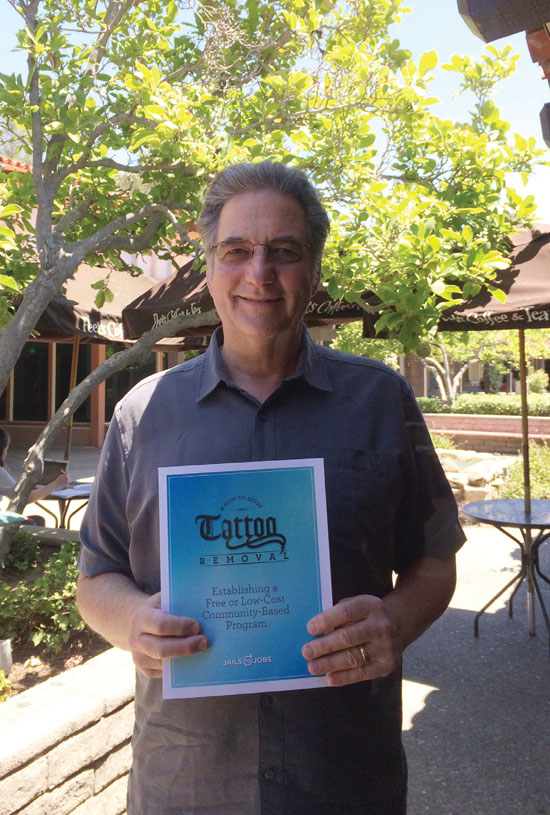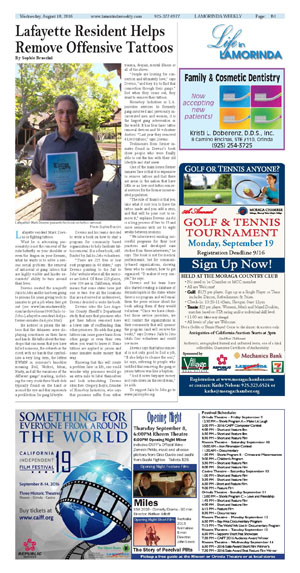| | Published August 10th, 2016
| Lafayette Resident Helps Remove Offensive Tattoos
| | | By Sophie Braccini |  | | Lafayette's Mark Drevno presents his book on tattoo removal. Photo Sophie Braccini |
Lafayette resident Mark Drevno is fighting tattoos.
 What he is advocating passionately is not the removal of the cute butterfly on your shoulder or even the dragon on your forearm; what he wants is to solve a serious social problem: the removal of antisocial or gang tattoos that are highly visible and hinder ex-convicts' ability to turn around their lives.
What he is advocating passionately is not the removal of the cute butterfly on your shoulder or even the dragon on your forearm; what he wants is to solve a serious social problem: the removal of antisocial or gang tattoos that are highly visible and hinder ex-convicts' ability to turn around their lives.
 Drevno created the nonprofit Jails to Jobs and he has been going to prisons for years giving tools to inmates to get a job when they get out (see www.lamorindaweekly.com/archive/issue0906/Jails-to-Jobs-Lafayette-resident-helps-former-inmates-find-jobs.html).
Drevno created the nonprofit Jails to Jobs and he has been going to prisons for years giving tools to inmates to get a job when they get out (see www.lamorindaweekly.com/archive/issue0906/Jails-to-Jobs-Lafayette-resident-helps-former-inmates-find-jobs.html).
 He noticed in prison the tattoos that the detainees were displaying sometimes on their faces and hands. He talks about the teardrops that can mean that you have killed someone, the cobweb or the clock with no hands that symbolizes a very long term, the letters EWMN on someone's knuckles meaning Evil, Wicked, Mean, Nasty, and all the variations of the different gangs' marking, including the very crude three black dots typically found on the hand or around the eye and that represents a predilection for gang lifestyle.
He noticed in prison the tattoos that the detainees were displaying sometimes on their faces and hands. He talks about the teardrops that can mean that you have killed someone, the cobweb or the clock with no hands that symbolizes a very long term, the letters EWMN on someone's knuckles meaning Evil, Wicked, Mean, Nasty, and all the variations of the different gangs' marking, including the very crude three black dots typically found on the hand or around the eye and that represents a predilection for gang lifestyle.
 Drevno and his teams decided to write a book on how to start a program for community based organizations to help facilitate tattoo removal. It is a free book, self-funded by Jail-to-Jobs volunteers.
Drevno and his teams decided to write a book on how to start a program for community based organizations to help facilitate tattoo removal. It is a free book, self-funded by Jail-to-Jobs volunteers.
 "There are 225 free or low cost programs in 40 states," says Drevno pointing to the Jail to Jobs' website where all the services are listed. Of these 225 places, over 100 are in California, which means that some states have just one or two. For all the locations that are not served or underserved, Drevno decided to write the book.
"There are 225 free or low cost programs in 40 states," says Drevno pointing to the Jail to Jobs' website where all the services are listed. Of these 225 places, over 100 are in California, which means that some states have just one or two. For all the locations that are not served or underserved, Drevno decided to write the book.
 Drevno cites the Los Angeles County Sheriff's Department study that says that prisoners who get their tattoos removed have a lower rate of reoffending than other prisoners. He adds that gang tattoos can cause grave harm from other gangs or even their own when you want to leave it. Some tattoos are applied in prison and some inmates make money that way.
Drevno cites the Los Angeles County Sheriff's Department study that says that prisoners who get their tattoos removed have a lower rate of reoffending than other prisoners. He adds that gang tattoos can cause grave harm from other gangs or even their own when you want to leave it. Some tattoos are applied in prison and some inmates make money that way.
 Knowing that this will create a problem later in life, one could wonder why prisoners would go an extra mile to label themselves and look intimidating. Drevno cites Rev. Gregory Boyle, founder of Homeboy Industries, who says that prisoners suffer from either trauma, despair, mental illness or all of the above.
Knowing that this will create a problem later in life, one could wonder why prisoners would go an extra mile to label themselves and look intimidating. Drevno cites Rev. Gregory Boyle, founder of Homeboy Industries, who says that prisoners suffer from either trauma, despair, mental illness or all of the above.
 "People are looking for connection and ultimately love," says Drevno, "and they try to find that connection through their gangs." But when they come out, they want to remove their tattoos.
"People are looking for connection and ultimately love," says Drevno, "and they try to find that connection through their gangs." But when they come out, they want to remove their tattoos.
 Homeboy Industries in L.A. provides services to formerly gang-involved and previously incarcerated men and women; it is the largest gang intervention in the world. It has four laser tattoo removal devices and 34 volunteer doctors. "Last year they removed 43,000 tattoos," says Drevno.
Homeboy Industries in L.A. provides services to formerly gang-involved and previously incarcerated men and women; it is the largest gang intervention in the world. It has four laser tattoo removal devices and 34 volunteer doctors. "Last year they removed 43,000 tattoos," says Drevno.
 Testimonies from former inmates found in Drevno's book show people who were finally able to cut the ties with their old lifestyle and start anew.
Testimonies from former inmates found in Drevno's book show people who were finally able to cut the ties with their old lifestyle and start anew.
 One of the main issues former inmates face is that it is expensive to remove tattoos and that there are areas in the nation that have little or no low-cost tattoo removal services for the former incarcerated population.
One of the main issues former inmates face is that it is expensive to remove tattoos and that there are areas in the nation that have little or no low-cost tattoo removal services for the former incarcerated population.
 "The rule of thumb is that you take what it cost you to have the tattoo made and you add a zero, and that will be your cost to remove it," explains Drevno. And it is a long process of two to 15 and more sessions with six to eight weeks between sessions.
"The rule of thumb is that you take what it cost you to have the tattoo made and you add a zero, and that will be your cost to remove it," explains Drevno. And it is a long process of two to 15 and more sessions with six to eight weeks between sessions.
 "We interviewed existing successful programs for their best practices and developed case studies from these interviews," he says. The book is not for medical professionals, but for community-based organizations, showing them who to contact, how to get organized. "It makes it very simple," he says.
"We interviewed existing successful programs for their best practices and developed case studies from these interviews," he says. The book is not for medical professionals, but for community-based organizations, showing them who to contact, how to get organized. "It makes it very simple," he says.
 Drevno and his team have also started creating a database of dermatologists in the states where there is no program and will email them the press release about the book asking them if they would volunteer. "Once we have identified those service providers, we will contact the organizations in their community that will sponsor the program (and will receive the book)," says Drevno. Jails to Jobs totals four volunteers and could use more.
Drevno and his team have also started creating a database of dermatologists in the states where there is no program and will email them the press release about the book asking them if they would volunteer. "Once we have identified those service providers, we will contact the organizations in their community that will sponsor the program (and will receive the book)," says Drevno. Jails to Jobs totals four volunteers and could use more.
 Drevno says that tattoo removal is not only good to find a job, "It also helps to cleanse the soul," he says, referring to people who testified that removing the gang or prison tattoos was like a baptism.
Drevno says that tattoo removal is not only good to find a job, "It also helps to cleanse the soul," he says, referring to people who testified that removing the gang or prison tattoos was like a baptism.
 "And it saves taxpayer money as it cuts down on the recidivism," he adds.
"And it saves taxpayer money as it cuts down on the recidivism," he adds.
 To support Jails to Jobs go to www.jailstojobs.org.
To support Jails to Jobs go to www.jailstojobs.org.


|
| | | | | | | | | | | | |



